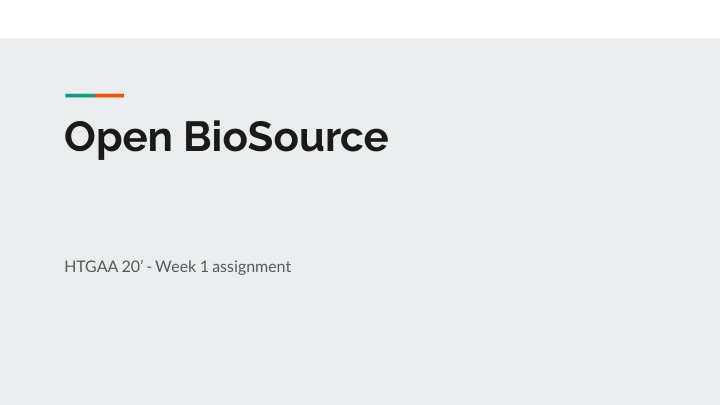



Open BioSource HTGAA 20’ - Week 1 assignment
Goals & Rationale - Inspired by Software Engineering - Open Source philosophy and ecosystem - “given enough eyeballs, all bugs are shallow" (Linus’s law) - Software bugs are analogous to risky bio workflows. - Open vs. closed source security is a matter of active debate. - Creators share readable code (-> workflow), the community can flag issues, and suggest practical fixes (“merges/pull requests”) - Open Source Mentality - BioHackers should document their workflow and be open to sharing as well as accepting suggestions for improvements. - Open Source Ecosystem - BioHackers should have access to a suite of tools that will allow comfortable recording of workflows, including detailed history of changes to the workflow, and be able to share and receive feedback. - The goal is to prevent hazardous workflows, for the biohacker or the environment.
Principles: Reproducible Design & Requirements ● Auditable ● Contributable ● 1. Mentality: Education - in events such as iGEM ○ Create a common language for protocols and workflows ○ Reward active community members ○ 2. Ecosystem: Electronic Lab Notebooks (ELNs) - right now there are a plethora of solutions (e.g. Benchling) yet a lot of researchers ○ still use paper notebooks (Kwok 2018) Adapting a common protocol to be used by all ELNs ○ BioGithub - easy access to a repository full of community-vetted workflows ○ Documenting your workflow should be easy and not add any extra labour to an already labour-full project ○ Smart Lab - a lab can be equipped with simple sensors that will log each machine use, thus automatically creating an ○ almost workflow for an experiment
Assumptions & Risks - Sharing private workflows might lead to: - Research Plagiarism (scooping) - Misuse of sensitive, dangerous biotechnology - Only works if there’s a strong active community - Mentality cannot be implemented without the proper tools and ecosystem, and vice versa - chicken and egg.
Recommend
More recommend